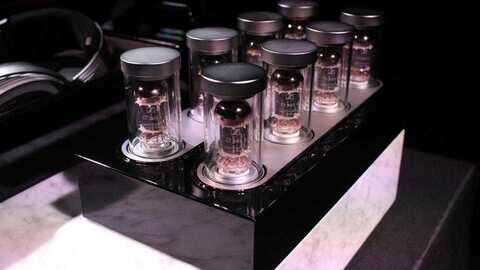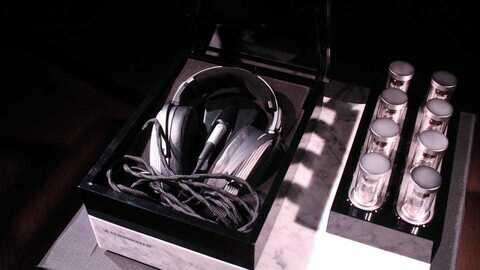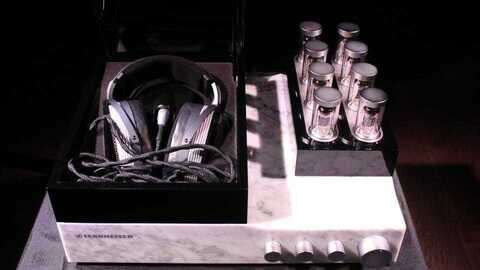Sennheiser's new glorious €50,000 Orpheus headphones
Sennheiser's original Orpheus headphones are somewhat of a legend in the headphones world. Launched back in the early 90s, the Orpheus was born out of Sennheiser's challenge to its engineers to create the best possible headphones. The sky was the limit when it came to price. Unsurprisingly, then, Orpheus HE90 and its accompanying HEV-90 tube amplifier set you back $16,000. Only 300 were ever made, so they became a collector's item.
It wouldn't be a surprise to see them selling for twice that price nowadays. Sennheiser has been celebrating its 70th anniversary and teased a successor to the Orpheus as part of festivities a few weeks ago. Today, 25 years on from the original launch, I got to listen to the new Orpheus and boy did they not disappoint.
The amplifier is crafted from Carrara marble, the same material supposedly used by Michelangelo for his famous sculptures. The amplifier houses platinum-vaporized, 2.4 micrometer diaphragms and the headphones will support a staggering frequency range of 8Hz to 100,000kHz, which is well beyond the human ear's capabilities. Axel Grell, Sennheiser Product Manager Audiophile, said the frequency range was the equivalent of combining a bat with an elephant. Needless to say, nothing from your music should get lost.

There's actually a second ultra-high impulse amplifier stage integrated into the cups of the headphones. Sennheiser says this brings a 200% rise in efficiency as most of the amplifier power is typically lost in the cable. “Our approach was, therefore, to amplify the alternating voltage to high voltages not at the beginning of the cable but at the point where it is really required – directly at the gold-vaporised ceramic electrodes in the headphones themselves.”
All in all, there are 6,000 individual components inside the amplifier and headphones. Axel said that Sennheiser expects to be able to manufacture 250 Orpheus headphone and amplifiers a year. Interestingly, the plan isn't to stop at 250 so there won't be the limited numbers like the original Orpheus.
Video of Sennheiser Orpheus powering on action
The listening experience begins with turning the amplifier on by pressing the volume dial. This engages an incredibly elegant powering on action that sees the tubes raise out of the amplifier, the control dials extend out and the headphones' case open. The headphones case opens last and is timed with the tube amps being in a warm enough state. It's a sight to behold and adds a degree of luxury to the listening experience. Having said that, if you can afford the €50,000 price I'm sure you're not lacking in luxury elsewhere in life. Still, it's a wonderful spectacle.
The headphones themselves feel heavy when you first pick them up, but any initial fears about comfort are dissuaded once you put them on. The circumaural pads are incredibly comfortable and you don't feel the weight on top of your head. The one word you can use for describing the listening experience is 'comfort'. This extends to wearing them as well as the sound signature itself.
I listened to some Gregory Porter and the best way to describe the sound was comfortable. I could easily lose myself to Porter's sultry tones for his track 'Moanin'. No distortion, no discomfort, no harshness or brightness. Just lots of refined transparency to the sound, while I was carried off on a cloud of comfort. I was only listening to a CD, so not a high-resolution audio file or anything that really pushed the Orpheus' capabilities. But still, it sounded wonderful. I only had 20 minutes with the headphones, so more time is needed, especially with more of my familiar test tracks, but I could have happily sat there the rest of the day enveloped in the Orpheus' sound. When the session came to an end I actually felt disappointed.

The only possible detractor I had from the Orpheus was its cable management. The headphone cable is heavy duty, braided cable that will let you get to a comfortable listening position, which is great. But there's no real cable management for when the headphones are put back in their display case. You sort of just bunch them up at the front haphazardly. Considering there's so much attention to detail and elegance elsewhere, it seemed like an oversight. There was certainly room to make the headphone case larger to accommodate the cable in a more attractive way. Axel Grell said there was likely an engineering reason for it.
In the end, as with anything 'audiophile'-related, there's the law of diminishing gains. If you can afford to even consider these, chances are you're not going to be disappointed.
